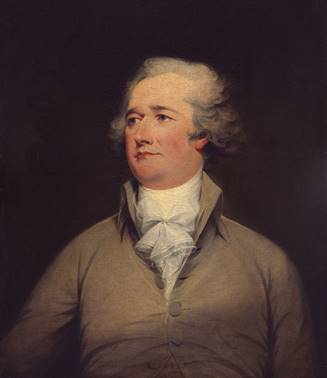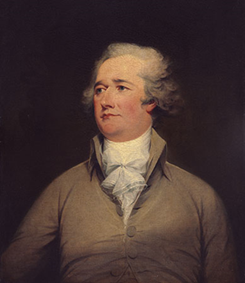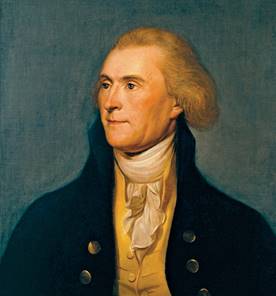Federalist and Anti-Federalist

Alexander
Hamilton wrote most of the essays that make up the Federalist Papers.
Unit Overview
In this
unit, students will cite arguments used by the Federalist and Anti-Federalist
during debates for the ratification of the U.S. Constitution. (CS#6).
Section A: Content Statement 6
The Federalist Papers and the Anti-Federalist Papers framed the national
debate over the basic principles of government encompassed by the Constitution
of the United States and led to the adoption of the Bill of Rights.
Content Elaboration
The
supporters of the ratification of
the Constitution became known as Federalists and the opponents as Anti-Federalists.
The Federalist Papers and the Anti-Federalist Papers discussed critical
principles of government as they related to the circumstances of that time.
Federalists argued:
for Constitutional ratification;
for the supremacy of the national government;
for more powers to be given to the federal
government to address weaknesses of the Articles of Confederation
for the "necessary and
proper" and "supremacy" clauses.
Anti-Federalist argued:
against Constitutional ratification;
for supremacy of the state governments;
for the need of a national bill of
rights to protect citizens from the powers of the federal government; and
against the "necessary and
proper" and "supremacy" clauses.
The Constitution was ratified, and the
Anti-Federalists achieved success with the limitations on government by the
adoption of the Bill of Rights.
Let's Practice: Federalist and Anti-Federalist
Section B: Federalist and Anti-Federalist
The Framers were aware that the existing
Congress and state legislatures would not be happy with the new, stronger
national government they were proposing. Therefore, they had included a process
for ratifying the Constitution that would bypass both groups, instead of
calling for voters to elect representatives to a state ratifying convention.
The Constitution would become law
once 9 of the 13 states ratified it.
The battle
for ratification involved the
Antifederalists, the opponents of the Constitution, and Federalists, the
supporters of the Constitution.
Antifederalists claimed
that the national government proposed by the Constitution would become too
strong and threaten republicanism and state sovereignty. They also criticized
the absence of a bill of rights, without which they feared the new national
government could violate personal civil liberties with no fear of punishment.
Federalists countered that a
sufficiently powerful national government would strengthen the union of the
states and have the power to defend the nation against foreign enemies,
regulate trade, and control internal disturbances like the earlier Shay's
Rebellion. Federalists also highlighted how the separation of powers officially
limited federal power.
|
Federalist |
Anti-Federalist |
|
For the Constitution |
Against the Constitution |
|
Abandoned Articles of Confederation |
Amend Articles of Confederation |
|
National power is the highest |
State power is the highest |
|
No need for Bill of Rights |
Need Bill of Rights |
|
Large Republic |
Small Republic |
|
Made up of wealthy and ordinary citizens |
Made up of farmers and debtors |
|
Alexander Hamilton
|
Thomas Jefferson
|
One key argument during the ratification debate concerned the extent of
power that should be held by the national
government.
Federalists argued that the powers bestowed upon the national government
helped to counteract the problems encountered under the Articles of
Confederation. State sovereignty would have to give way in favor of the general
welfare of the nation. In any case, according to the Federalists, federal power
was defined and limited, while the states still held many residual powers.
The Anti-Federalists responded
that the significant powers to govern had been delegated to the national
government and that the states had little role other than to oversee the
selection of federal officials. Also, argued the Anti-Federalists, the "necessary
and proper" and "supremacy" clauses rendered ineffective any
limitations on the powers of the national government.
Federalists can be said to have won the overall debate on the basic
principles of government with the ratification of the Constitution of the
United States. Anti-Federalists did achieve some success with the limitations
on government embraced by the Bill of
Rights.
Let's Practice: Classify
Section C: Bill of Rights
The Federalists had been better prepared
for the fight over ratification than the Antifederalists, quickly pointing out
to small states that they would have equal representation in the Senate,
despite their low populations. Yet Federalists found the largest and most
powerful states challenging to persuade. Federalists finally agreed to the
Antifederalists' demand for a bill of
rights. This change had a remarkable effect on ratification. On June 21,
1788, the ninth state ratified the Constitution, and the remaining four states ratified
it shortly after that.
Once the
first Congress met, James Madison
emphasized that the promised bill of rights should be proposed and ratified
quickly. Madison suggested many amendments, or changes to the Constitution,
that reflected earlier declarations of rights, including the English Bill of Rights
and the Declaration of Independence. In September 1789, Congress sent 12
amendments to the states for ratification. By December 1791, the states had
ratified 10 of the amendments. Traditionally called the Bill of Rights, these ten
amendments protect several civil liberties and civil rights, including the
freedom of speech, press, and religion.
Lets Practice: True or False

